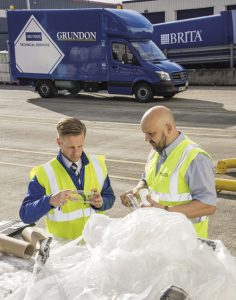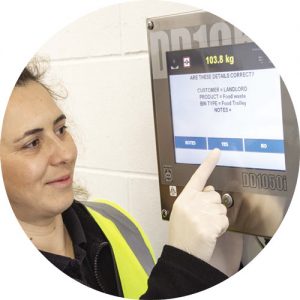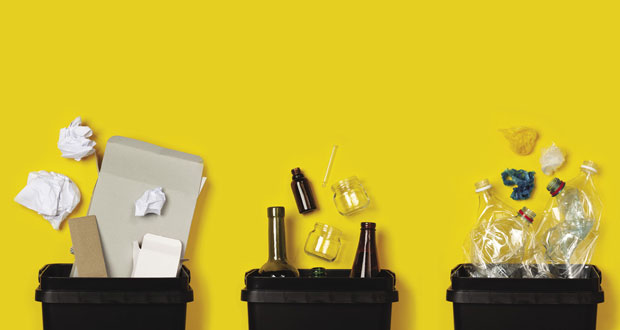RECYCLING TARGETS
Waste and recycling may have been greatly disrupted due to the lockdowns of the past year, but the waste management experts advise that it’s a good time to start afresh by carrying out a fresh waste audit. Your business may have changed, employee levels will have changed, and the amount and types of waste will undoubtedly have changed too.
Explains Yarrow: “A waste composition analysis means we literally tip out your waste and go through it, item by item, analysing where it comes from, how much of it there is and even why you need it. We’ve helped a number of customers to reduce their waste by making sure their suppliers take back items rather than leaving them as the customer’s responsibility.
 “A typical example is BRITA UK, which successfully removed metal from its waste stream altogether, simply by asking contractors to take their waste away with them. Within the healthcare environment we successfully introduced a specialist take-back scheme for single-use PVC – typically used for oxygen masks and tubing – which would previously have gone for incineration.
“A typical example is BRITA UK, which successfully removed metal from its waste stream altogether, simply by asking contractors to take their waste away with them. Within the healthcare environment we successfully introduced a specialist take-back scheme for single-use PVC – typically used for oxygen masks and tubing – which would previously have gone for incineration.
He adds: “Opportunities for recycling and reuse are improving all the time, from recycling paper cups, to chewing gum and even cigarette butts, waste is increasingly being seen as adding value and becoming a commodity of its own. The trick is to be able to harness that for the advantage of the customer.”
Recycling has a key role to play towards reaching net zero carbon as it actually saves a significant amount of climate damaging emissions compared with use of virgin materials. While it remains a high priority for FMs, the enforced hiatus could require some re-education of staff to recycle and reliance on single-use plastic.
Says Aragon: “During COVID it became necessary to move to single-use packing and containment, especially in catering provision. Substitution towards compostable items was made but significant increases were seen in the general waste side, and ultimately a reduction in the waste hierarchy for many clients.
“The key to increase sustainability, and limit environmental impact and carbon emissions is reduction, reuse, and the optimisation of recycled content. This covers effective waste management to treat packaging at its end of life. Importantly recycling always wins over virgin production on all environmental indicators.
“For plastics, it has been shown that recycling saves between 30 per cent and 80 per cent of the carbon emissions that virgin plastic processing and manufacturing generate. If all plastic were recycled this could result in mean annual savings of 30 to 150 million tonnes of CO2, equivalent to shutting between eight and 40 coal-fired power plants globally.”
Yarrow believes that employee engagement is now more critical than ever.
“Everyone needs to realise that they can do their part in the drive towards carbon zero; whether it’s making the decision not to use single-use plastics, to dispose of items in the correct bins, and to think carefully about purchasing decisions throughout the supply chain.
“For example, there has been an increasing trend towards new materials entering the waste chain – such as compostable and PLA packaging and other items made from raw products such as corn starch and sugar cane. In theory, it reduces the use of plastics but the reality is that we’ve ended up with a new waste stream without a recycling process, which is degrading the value of genuinely recyclable plastic and fibre products.”
SMART WASTE
A report published in March 2021(6) on smart waste management revealed that Governments across the world, along with health governing authorities such as WHO had released guidance and regulations regarding the use of smart waste management processes that could help lower the spread of Coronavirus. It also predicted that the production, distribution, and procurement of equipment, devices, and tools for smart waste management will begin getting back on track during the post-lockdown period, which will help streamline collection and disposal processes.
 Grundon has already implemented a number of new ideas for customers, such as new on-site weighing scales which are really revolutionising waste charges, especially in multi-tenant office facilities.
Grundon has already implemented a number of new ideas for customers, such as new on-site weighing scales which are really revolutionising waste charges, especially in multi-tenant office facilities.
Explains Yarrow: “Instead of being billed for an average cost based on the overall amount of waste taken away, the new weighing facilities allow each tenant to be charged for only the exact amount of their own waste – and of course, that’s going to become even more important as different customers return to work at different stages. Each tenant is given an individual PIN so, once the cleaning team has removed the waste to the loading bay, the operative inputs that code into the screen to record exactly the weight and type of waste from that customer’s offices.
“Monthly reports and analysis can then be sent to the managing agent (or directly to the tenant if appropriate) and it means FMs can work closely with the waste providers and the tenants to introduce whatever changes may be necessary to improve their recycling figures and meet their targets.
“In addition, a number of our vehicles also have weighing facilities so collections can be monitored at source and reports fed back to customers to help them determine any changes to be made.”
Waste and recycling targets will have been greatly disrupted due to the lockdowns of the past year, and FMs may be looking to waste management experts help clients re-evaluate and meet their targets.
“This is a good time to review waste streams and to look at new possibilities,” says Aragon.
“It is likely that 2020 data sets will be the baseline for at least the next year or so. Looking at planned headcounts and adjusting targets in proportion will give more realistic targets for clients, but the changes don’t mean that new targets can’t be set. With work forces returning to the workplace or adapting permanently to a more flexible working and attendance it is a great opportunity to look at improving facilities, and looking at new waste separation at source to increase opportunities for recycling.”
(1) www.adeptnet.org.uk/covid-19-waste-survey-results
(2) www.grundon.com
(3) www.veolia.co.uk
(4) www.initial.co.uk
(5) www.gov.uk/government/publications/coronavirus-covid-19-lateral-flow-tests-waste-codes/waste-codes-for-mass-testing-with-lateral-flow-antigen-testing-devices
(6) www.alliedmarketresearch.com/request-sample/9105





